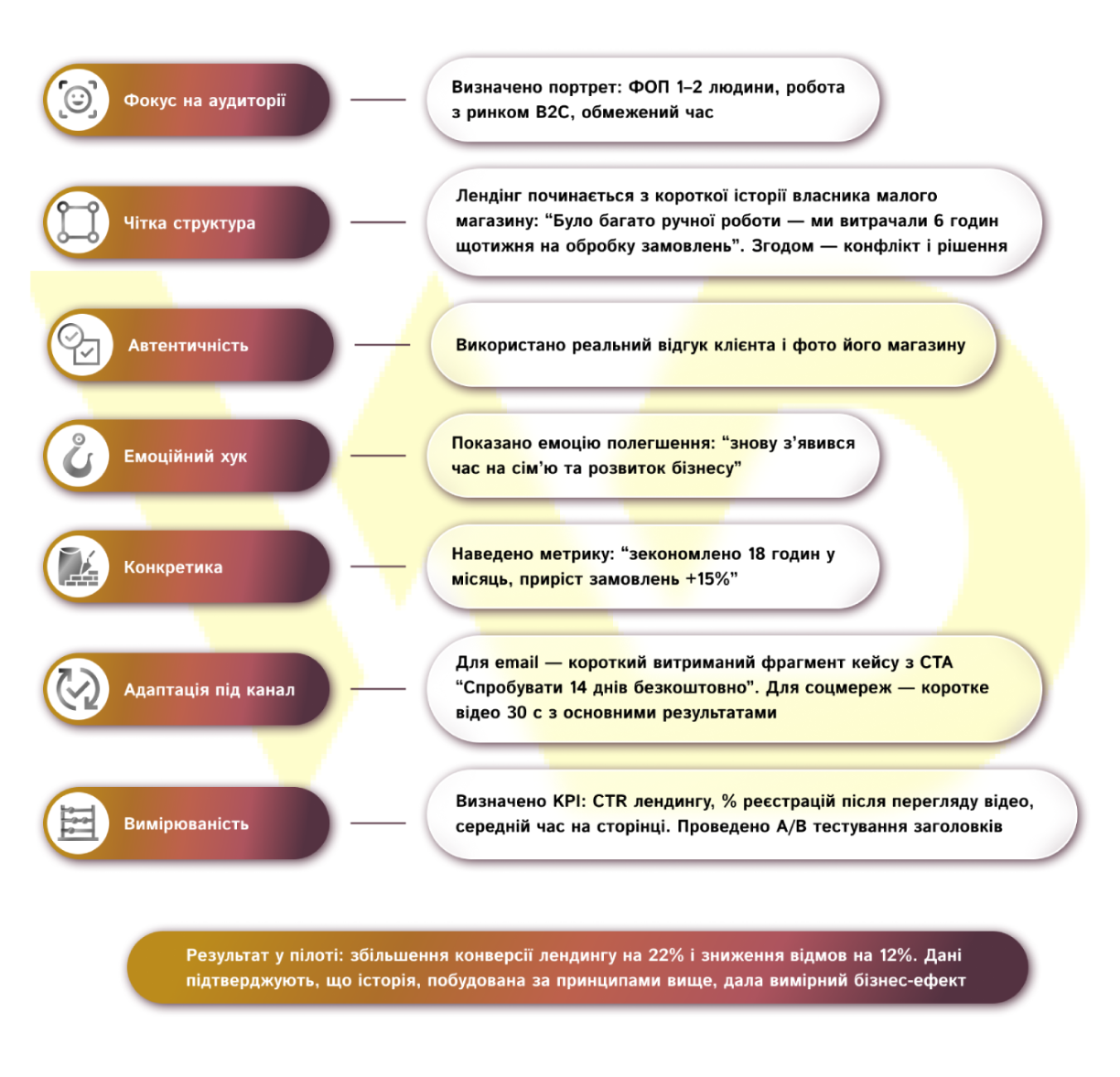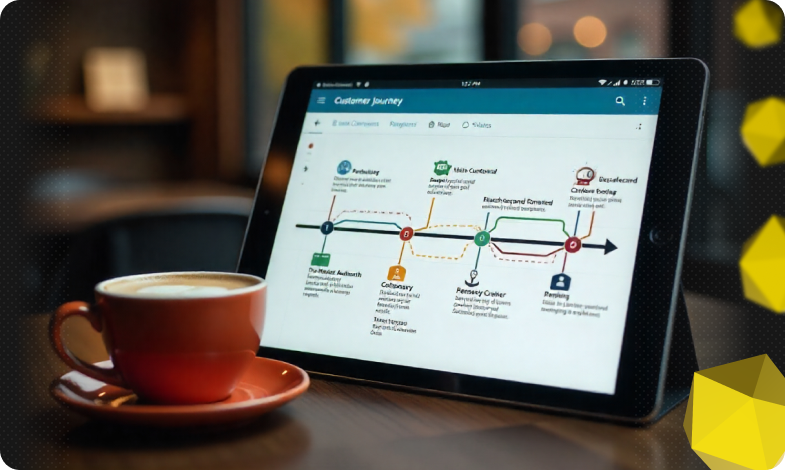Content of the article
- /01 What is storytelling and why does it work?
- /02 Types of storytelling in marketing
- /03 Principles of effective storytelling
- /04 Tools and formats in digital
- /05 Repurposing: how to get the most out of one story
- /06 How to create a selling story: a step-by-step guide
- /07 How to measure the effectiveness of storytelling
- /08 Recommendations for implementation


In the world of digital marketing, user attention is becoming increasingly expensive. People see hundreds of advertising messages every day, but of course, not all of them are memorable. That’s why the ability to tell compelling stories has become one of the most important tools that help businesses grow.
In this article, we’ll look at what storytelling is in marketing, why it works, what types of stories there are, and how to use stories to promote brands in the digital environment.
What is storytelling and why does it work?
Storytelling is a communication method based on telling stories that attract attention, evoke emotions, and build trust. In marketing, it helps to turn dry facts about a product or service into a lively story with a hero, a problem, and a solution.
Stories activate not only logic but also emotions, because people remember a story better than a set of characteristics. That’s why a message in the form of a story stays in the memory ten times longer and has a higher impact on the purchase decision.
Types of storytelling in marketing
Storytelling is not universal: different types of stories solve different problems, appeal to different audiences, and require their own presentation. Below are brief definitions of the main types.
- Consumer storytelling.
These are stories of real customers about their difficulties and results after using your product or service. This format is effective when you need to increase trust and remove objections from potential buyers. It is worth using case studies, video testimonials, or short quotes from interviews on landing pages and in advertising creatives.
For example, a coffee shop owner explains how the introduction of an automation system reduced service time by 30% and increased the average check, and this greatly convinces potential customers.
- Product storytelling.
It demonstrates how a product or service solves specific tasks of the user. It is used when launching new products, complex solutions, or to emphasize the USP. It works best in demo videos, interactive guides, and landing pages.
- Brand storytelling.
Brand storytelling tells about the company’s history, values, and vision. It helps build long-term loyalty and recognition. Formats include brand films, the «About Us» section, and a series of publications with backstory materials.
- Anti-crisis storytelling (failure stories).
These are frank stories about mistakes, lessons, and next steps. It is used to restore trust during reputational challenges or rebranding. Formats include public statements, documentary materials, and detailed blogs with an analysis of the situation.
- Storytelling through social proof.
This format relies on the experience of other users or influencers to build trust. It is suitable for speeding up decision-making among hesitant audiences. Formats include reviews, ratings, case studies, and collaboration with influencers.
- Mission stories.
Such storytelling reveals the social or environmental goal of the business and its implementation. It is used to attract an audience that values ethics and responsibility.
- Transformational storytelling.
The transformational format shows a clear change «before» and «after» the use of the product. It is effective for demonstrating obvious results – visual, financial, or operational.
Example: a cleaning company illustrates the results of cleaning with photo evidence and a comparison of time and cost.
- Interactive and UGC storytelling.
Interactive storytelling involves the audience in creating content and co-creating brand stories. It increases engagement and builds community.

The choice of story type should be based on a clear business goal and expected effect, not on the desire to «do everything at once». The approach should be systematic – each story should have a defined success indicator, a measurement plan, and those responsible for implementation and analysis.
Principles of effective storytelling
Storytelling only works when the story is well thought out. Rules are needed to make the story understandable, relevant, and measurable. Without principles, the message risks becoming an emotional episode without a business result. Below is a set of practical principles that increase the likelihood of success in digital campaigns.
- Focus on the audience.
The story begins with a clearly defined person (hero). You need to understand their needs, barriers, decision-making context, and language peculiarities – this determines the tone, format, and channel of communication.
- Authenticity and transparency.
Trust is built on true facts: real quotes, photos, screens, documented results. A discrepancy between what is stated and what is real undermines reputation faster than a lack of creativity.
- Specifics and evidence.
Figures, time frames, before/after indicators make the story measurable and allow you to link it to business goals. Specificity makes it easier to test hypotheses and scale.
- Adaptation to the channel.
One idea – many pitches. Each version retains the central thesis and at least one proof, but the shape, length, and CTA change according to the expectations of the platform.
- Measurability and optimization cycle.
KPI are determined before launch, control points are set (for example: 7 days / 30 days / 90 days), A/B tests are conducted, and results are recorded for subsequent stories.
An example of applying the principles
Company: an online service for small businesses for sales automation.
Goal: to increase the conversion of landing pages and reduce the doubts of individual entrepreneurs about switching to the platform.

The application of these principles shows that storytelling in digital marketing is not only a tool for emotional impact but also a clearly measurable business resource. Well-thought-out stories can combine trust and facts, create an emotional connection with the customer, and at the same time demonstrate a concrete result. It is the balance between creativity and structure that makes stories a powerful tool for brand growth and sales.
Tools and formats in digital
Tools and formats are a way to bring a story to life where the audience can see and feel it. The choice should be based on the goal of the campaign, the stage of the funnel, and the habits of the target audience. Let’s look at the main formats and their features.
Video (short and long formats)
Video combines visual narrative, sound, and text, making it one of the most powerful tools for conveying emotion and context. Short videos (15-60 seconds) are used as teasers and for social media; longer videos (2-10 minutes) are suitable for detailed case studies or brand films on YouTube. Important elements are a strong hook in the first seconds, clear drama, and subtitles for viewing without sound.
Social media (series of posts, Stories, Reels)
Social media allows you to break your story into micro-episodes and get quick feedback. Emotional short forms and visual carousels are suitable for Instagram and TikTok, while LinkedIn requires a more professional presentation and longer texts for B2B. The format should be tailored to the behavior of the platform’s audience: a series of posts or stories create a consistent narrative, and interactive elements (polls, Q&A) increase engagement.
Email marketing (story email, series of triggers)
Email remains an effective channel: one case study can be expanded into a series of emails, where each email reveals a different aspect of the story. The subject line and the first paragraph should contain a «clue», and the body of the email should contain a short narrative with a CTA. Personalization and segmentation increase relevance.
Landing pages and landing pages
A landing page is a controlled point of contact where the story should end with a conversion. The page structure should lead from a headline that resonates with the pain, through the «before/after» block with metrics to social proof and a clear CTA. Visual evidence and short quotes from customers build trust.
Blog and long-form content
Blogs are suitable for in-depth case studies, analytics, and SEO. The publication can contain an extended implementation timeline, a methodology for measuring results, and graphs. It is important to optimize the structure for search queries and integrate internal links to service pages.
Podcasts and audio content
The audio format allows you to discuss a case in detail in the format of an interview or a serial narrative. Podcasts are convenient for professional audiences who consume content on the go or while working. For each episode, it is recommended to make a transcript for SEO and short cuts for social media.
Interactive formats (quizzes, calculators, interactive cases)
Interactive attracts attention and personalizes the experience. For example, a quiz can identify user needs, and a calculator can show the economic benefits of a product based on specific data. Interactivity should be simple and provide quick results.
UGC and community campaigns
UGC works as social proof: user-generated content is more trustworthy than branded materials. Contests, hashtag campaigns, and sections with customer stories allow you to accumulate community content. Important rules: clear terms of participation and republishing channels.
Visualization: photos, infographics, animation
Visual elements speed up the perception of complex data and enhance the emotional effect. Infographics, authentic photos, and animations are useful for explaining processes in a short format. Visual blocks should support the main thesis of the story, not distract from it.
Paid media and native integrations
Paid media distribution allows you to scale the story and fine-tune the target audience. The effectiveness depends on adapting creatives to the placements, testing creative options, and using remarketing to re-contact interested users. Native integrations, such as sponsored content and affiliate articles, build trust through authoritative platforms.
How to choose formats – a short algorithm

Repurposing: how to get the most out of one story
One high-quality story gives you several cycles of content when properly repurposed. The full video serves as a base: short teasers for social media, cuts for stories, and audio files for podcasts are cut from it. The transformed text case forms the basis of a blog, and quotes and short blocks for email newsletters are extracted from the blog. Infographics are created based on the case metrics and placed on the landing page and in sales presentations. User-generated content (UGC) is collected in a separate collection or collage video, which strengthens the social proof. An important technical aspect is that each piece of content is labeled with UTM tags and integrated with analytics and CRM to track the audience’s journey from first contact to conversion. This approach reduces production costs, increases reach, and provides a repeatable source of content for different stages of the funnel.
The system of format selection and repurposing ensures that each story created works across multiple channels and generates a measurable business effect.
How to create a selling story: a step-by-step guide
A step-by-step methodology allows you to turn an idea into a well-thought-out story that works for a business goal. So, here is a step-by-step guide.
STEP 1. Generating and selecting ideas.
The first step is to quickly collect ideas from sales, customer service, product, analytics, and customer feedback. At the same time, search trends and industry indicators are taken into account. To save time, ideas are collected at a short workshop (30-60 minutes), where each idea is assigned a business goal, expected impact metric, estimated resource, and potential risks.
Responsible: content strategist (moderator), product marketer, sales representative.
Deliverables: a selection table (3-5 priority ideas) with recommendations for further action.
STEP 2. Building the drama.
Based on the selected idea, a short synopsis (150-300 words) is prepared according to the following scheme: context – conflict – solution – measurable result. The synopsis should include at least one quantitative metric «before/after» and indicate the source of evidence (quote, screen, document). At the same time, create a list of key elements of the script or sections for future formats.
Responsible: content strategist, copywriter or scriptwriter; consultation with a product or analyst.
Deliverables: a text synopsis and a checklist of key scenes/sections for production.
STEP 3. Production and preparation of materials.
The synopsis is transformed into a set of assets: the main video or text case, accompanying photos, infographics, and short cuts for social media. Each artifact should directly confirm the key thesis (with a number or evidence). At this stage, technical requirements (formats, subtitles, sizes) and legal issues (client consents, content rights) are resolved.
Responsible: production manager, videographer and/or photographer, designer, copywriter, lawyer – if necessary.
Deliverables: a complete package of materials ready for adaptation and publication.
STEP 4. Adaptation for channels.
The package of materials is split into versions for priority platforms: short teasers for social media with a hook in the first seconds, a laconic lead and CTA for email, a detailed case study for a blog or landing page. It’s important to keep the main idea and at least one proof in each version so that communication is consistent.
Responsible: SMM manager, email marketer, copywriter, designer.
Deliverables: ready-made creative packages (materials + texts + recommended CTA for each channel).
STEP 5. Publication and distribution.
The launch takes place according to the media plan: organic posts, targeting, remarketing, native integrations, or affiliate placements. It is mandatory to set UTM tags for all links and set up lead transfer to CRM. The sales team receives a brief case summary and a standard lead management scenario.
Responsible: media planner or targeting specialist, SMM, CRM administrator, sales manager.
Deliverables: a launched campaign with tracking and an agreed lead processing plan.
STEP 6. Testing and optimization.
After the launch, the campaign is monitored at certain control points (for example, 7 days, 30 days, 90 days). Perform A/B tests of headlines, the first 3-5 seconds of the video, CTA variants, and landing blocks. They also analyze CTR, conversions, CPL/CAC, and other relevant KPIs. Based on the data, they implement winning variants, record conclusions, and make recommendations for scaling or repositioning.
Responsible: analyst, targeting specialist, content strategist.
Deliverables: a report with the results, a list of changes, and a knowledge template for the next stories.
A clear structure, audience relevance, and continuous optimization ensure that the story does not remain an emotional episode but becomes a tool for sales and brand growth.
How to measure the effectiveness of storytelling
For a story to work for a business, its impact needs to be measured not only at the level of views or likes. Each format and channel has its own metrics, but it’s always important to look at the connection between the story and the ultimate business goals. Below, let’s look at what metrics to track and how to interpret them.
Basic engagement metrics
At the initial stage, it is worth assessing how much the story has interested the audience.
- Reach and views show how many people have seen the content. This is a basic level – if the reach is low, the story simply did not reach the target audience.
- The time spent viewing/reading gives an idea of whether the content really held attention. If most people leave the page after a few seconds, the story didn’t work.
- Interactions (likes, comments, shares, saves) signal an emotional response. The more dialogues and shares, the stronger the story’s potential to build loyalty and trust.
These indicators are important because they form the basis for further analysis. They allow us to understand whether a story has even gotten a chance to be heard, how well it holds attention, and whether it is able to evoke an emotional response. Without this, it is impossible to build effective next steps.
Conversion metrics
Once a story has garnered attention, the next step is to measure its ability to drive targeted actions.
- CTR (Click-Through Rate) shows how many users clicked on a link or pressed a button after viewing a story. This is a key indicator of how well the content encourages the next step.
- Conversion Rate shows how many people from the total audience performed the desired action: registered, left a request, made a purchase. This is a direct link between the story and the business result.
- Cost per lead/customer acquisition (CPL, CAC) helps to understand how well a story works in terms of budget.
These metrics are critically important because they show the real impact of the story on achieving commercial goals. If basic engagement rates indicate interest, conversions reflect the practical value of storytelling for business.
Metrics of long-term impact
In addition to immediate actions, it is worth considering how stories affect brand perception and loyalty building.
- The level of repeated interactions shows whether users return to your content and want to learn more.
- The growth of brand awareness can be measured through surveys, direct traffic, or the frequency of mentions on social media.
- Net Promoter Score (NPS) provides insight into whether customers are willing to recommend a brand to others, which is one of the key indicators of long-term value.
Such indicators do not always demonstrate immediate returns, but they help to assess the strategic impact of stories on the business. It is this data that shows whether storytelling can build sustainable trust, increase customer loyalty, and lay the foundation for future growth.
How to interpret the results
You shouldn’t evaluate the effectiveness of a story using only one indicator. For example, a high CTR with no conversions may mean that the story attracted attention, but the offer on the landing page was weak. Or vice versa – average reach can be offset by a high conversion rate among a narrow target audience.
It is useful to use an attribution model to understand what role the story played in the user’s chain of actions: whether it was the first contact that «sparked interest» or the final step before the purchase.

Proper measurement allows you not only to assess current performance but also to learn how to create even stronger stories in the future. This turns storytelling from a creative tool into a manageable business function.
Recommendations for implementation
For storytelling to become an effective digital marketing tool, it needs to be integrated into workflows that take into account channels, budget, and team roles. Stories are best used on social media, where they are easily scalable and quickly receive feedback from the audience. For the B2C segment, short videos and interactive formats that evoke emotions and stimulate sharing are most effective. At the same time, in B2B, it is appropriate to use longreads, case studies on the website, and webinars that provide a deeper immersion and allow you to build trust through expertise.
Budget guidelines depend on the formats chosen. Text stories and analytical materials can be created by an internal team at minimal cost. But videos, animations, or interactive tools usually require significant investment in production. On average, you should budget 15-20% of your marketing budget for storytelling and additionally allocate funds for promotion, because even the best story will not reach its goals without proper distribution.
It is equally important to build teamwork properly:
- A content strategist creates a common vision and integrates storytelling into the marketing strategy;
- a copywriter or content marketer is responsible for creating texts, scripts, and story structure;
- a designer and videographer turn stories into an attractive visual product;
- a targeting specialist or media planner ensures effective content distribution;
- an analyst monitors key metrics, interprets the results, and makes recommendations for optimization.
Thus, storytelling in digital marketing helps not only to attract attention but also to build long-term relationships with customers. Companies that systematically implement this technique gain a competitive advantage: their messages are easier to remember, and the brand is perceived as more open and close to the audience.






 17/11/2025
17/11/2025  1012
1012



